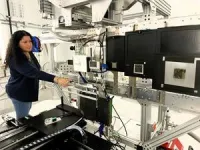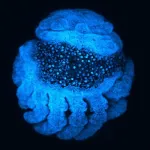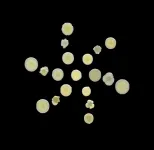(Press-News.org) The Department of Energy’s Oak Ridge National Laboratory added a new neutron scattering instrument to its powerhouse of discovery at the Spallation Neutron Source, charting new territory for neutron imaging through artificial intelligence. In July, DOE’s Office of Science approved the final commissioning of the Versatile Neutron Imaging Instrument, or VENUS.
“It’s a dream come true,” said ORNL neutron scattering scientist Hassina Bilheux. “It has been an honor and privilege to work with so many talented people dedicated to seeing VENUS through.”
Thanks to its cutting-edge features and the world’s most intense pulsed neutron beams, VENUS will help transform research in multiple areas of science. These include energy storage for better batteries, materials science for more efficient building materials, plant physiology for drought-resistant plants and more. VENUS will help push science forward by offering high-resolution 3D imaging with enhanced contrast that is sensitive to structural details at the atomic scale. Moreover, thanks to neutrons, VENUS won’t alter the extremely delicate materials researchers bring to ORNL for study.
In addition, VENUS will feature advanced computational methods that make the most of neutron beam time. During experiments, VENUS’s instrument scientists and users will use AI to produce 3D models of samples from time-of-flight raw data in significantly fewer measurements. Instead of experimenters waiting days or even weeks for 3D models of their samples from multiple radiographs, or images of internal form, research teams will have what they came for by the time they wrap up their experiments.
“VENUS offers broad capabilities for access to unique contrasts from many fields in science,” Bilheux said. “And with the help of AI, researchers can get their 3D data as soon as the experiment is over.”
VENUS also provides a platform for the United States to take a leadership role in the developing field of neutron imaging.
“We are thrilled to offer such one-of-a-kind capabilities to user communities around the globe,” said Jens Dilling, associate laboratory director for ORNL’s Neutron Sciences Directorate. “Considering some of the challenges we face as a nation and around the world, science and the talented people who make it happen, as here at VENUS, might be our greatest hope.”
The journey toward VENUS began in 2006 when Bilheux conceived an idea to create a neutron scattering instrument with enhanced imaging contrast for studying crystalline and amorphous samples at the atomic scale without damaging them. As an example, a NASA researcher, assisted by ORNL instrument scientists on the MARS beamline at ORNL’s High Flux Isotope Reactor, or HFIR, used neutrons to study extremely fragile moon rocks from Apollo missions. Together, NASA and the MARS team produced a high-resolution virtual rendering of the rocks to complement later measurements at VENUS. In the future, VENUS will help researchers understand the mineral content in the rocks for clues about early planetary formations and where we might find water on the moon.
No other research technique can nondestructively produce such results in 3D with precise information on atomic structure. Neutrons accomplish this because they pass easily through materials without damaging them. Neutron imaging scientists can probe thick samples, generate 3D images and build more complete microscale models of materials based on how neutrons scatter, or bounce, off atoms.
Efforts to use AI with ORNL’s beamlines began in recent years with the development of advanced algorithms that acquire data intelligently, autonomously and quickly. Working in collaboration with X-ray beamline teams at Brookhaven National Laboratory’s National Synchrotron Light Source II and Purdue University, ORNL’s SNAP neutron imaging beamline team published their latest results in Nature Publishing Group’s Scientific Reports, providing algorithms that form the basis for VENUS’s AI.
“We're very thankful for collaborating with our X-ray colleagues on this AI project,” Bilheux said. “This partnership helped set the stage for high-quality research results we expect will be game-changing in materials science.”
ORNL also formed a VENUS Advisory Committee that has remained involved since the construction project began. Physical construction for VENUS started in 2019, continued through the pandemic years, entered final phases in late 2023 and nears completion with plans for user beamtime beginning the last half of 2025.
“It takes a village to create such a complex instrument, and our entire ORNL team is very dedicated, which I’m very thankful for and very proud of,” Bilheux said. “Now she’s ready — it's time to come try things and push the limits of the instrument.”
SNS and HFIR are DOE Office of Science user facilities.
UT-Battelle manages ORNL for the DOE Office of Science, the single largest supporter of basic research in the physical sciences in the United States. The Office of Science is working to address some of the most pressing challenges of our time. For more information, please visit energy.gov/science. — Sumner Brown Gibbs
END
VENUS rising: A new dawn for AI-powered atomic-scale 3D imaging
2024-08-29
ELSE PRESS RELEASES FROM THIS DATE:
Machine learning helps identify rheumatoid arthritis subtypes
2024-08-29
A machine-learning tool created by Weill Cornell Medicine and Hospital for Special Surgery (HSS) investigators can help distinguish subtypes of rheumatoid arthritis (RA), which may help scientists find ways to improve care for the complex condition.
The study published Aug. 29 in Nature Communications shows that artificial intelligence and machine learning technologies can effectively and efficiently subtype pathology samples from patients with RA.
“Our tool automates the analysis of pathology slides, which may one day lead to more precise and efficient disease diagnosis and personalized treatment for ...
Ancient gene gives spiders their narrow waist
2024-08-29
An ancient gene is crucial for the development of the distinctive waist that divides the spider body plan in two, according to a study publishing August 29th in the open-access journal PLOS Biology by Emily Setton from the University of Wisconsin-Madison, US, and colleagues.
The spider body is divided into two sections, separated by a narrow waist. Compared to insects and crustaceans, relatively little is known about embryonic development in spiders, and the genes involved in the formation of the spider waist are poorly understood.
To investigate, researchers sequenced genes expressed in embryos of the Texas brown tarantula (Aphonopelma hentzi) ...
How a salt giant radically reshaped Mediterranean marine biodiversity
2024-08-29
A new study paves the way to understanding biotic recovery after an ecological crisis in the Mediterranean Sea about 5.5 million years ago. An international team led by Konstantina Agiadi from the University of Vienna has now been able to quantify how marine biota was impacted by the salinization of the Mediterranean: Only 11 percent of the endemic species survived the crisis, and the biodiversity did not recover for at least another 1.7 million years. The study was just published in the renowned journal Science.
Lithospheric movements throughout Earth history have repeatedly led to the isolation of regional seas from the ...
Bacteria able to overcome cost of vancomycin resistance in lab setting
2024-08-29
Staphylococcus aureus has the potential to develop durable vancomycin resistance, according to a study published August 28, 2024, in the open-access journal PLOS Pathogens by Samuel Blechman and Erik Wright from the University of Pittsburgh, USA.
Despite decades of widespread treatment with the antibiotic vancomycin, vancomycin resistance among the bacterium S. aureus is extremely uncommon—only 16 such cases have reported in the U.S. to date. Vancomycin resistance mutations enable bacteria to grow in the presence of vancomycin, but they do so at a cost. Vancomycin-resistant S. aureus (VRSA) strains grow more slowly and will often lose their resistance mutations if vancomycin ...
Wearable “smart mask” monitors disease by capturing and analyzing exhaled breaths
2024-08-29
A person’s exhaled breath – which provides information that could unveil diverse health insights – has been hard to analyze. Now, a novel “smart mask” provides real-time, non-invasive monitoring of what people exhale. The mask, dubbed EBCare, captures and analyzes exhaled breath condensate (EBC), and it offers a promising solution for continuous EBC analysis at an affordable cost. “The significance of EBCare lies in its role as a versatile, convenient, efficient, real-time research platform and solution in various medical domains, ...
Cultural traditions, not genetics or environment, inform nest architecture among white-browed sparrow weaver birds
2024-08-29
Challenging long-held beliefs that bird nest building is solely influenced by genetics or the environment, researchers report that the white-browed sparrow weavers of the Kalahari Desert, Africa, build nests with distinct architectural styles that reflect group-specific cultural traditions. “Behavioral traditions in birds have been well documented for song, migration, foraging, and tool use. Here, we add building behavior and show that architectural styles emerge from birds that build together,” write the ...
Oxidative damage riggers micronuclear collapse mechanisms in cancer, two studies report
2024-08-29
Reactive oxygen species (ROS) from mitochondria are key drivers of genetic chaos in cancer by causing the collapse of micronuclear envelopes, a process that fuels the chromosomal instability (CIN) often observed in aggressive tumor behavior. These are the findings of two new studies. The findings identify key proteins in this destructive process – p62 and CHMP7 – revealing potential prognostic markers and therapeutic targets for high-CIN tumors. Errors in chromosome segregation during cell division can lead to chromosomal instability, a key feature of cancer. These errors result in the formation of micronuclei, which are small structures ...
Messinian salinity crisis nearly reset Mediterranean biodiversity
2024-08-29
A meta-analysis of Mediterranean Sea marine species reveals the profound impact of the Messinian Salinity Crisis – a drastic environmental event that resulted in the almost complete evaporation of the Mediterranean Sea roughly 5.5 million years ago. According to the new study’s findings, the event nearly reset the region’s biodiversity. The findings offer novel insights linking tectonic and palaeoceanographic changes to marine biodiversity, highlighting the significant role of salt giants in shaping biogeographic patterns, including those that still influence ecosystems today. The Messinian Salinity Crisis (MSC), ...
Uncovering the secret communication of monkeys: They have names!
2024-08-29
New study from Hebrew University reveals that marmoset monkeys use specific calls, known as "phee-calls," to name each other, a behavior previously known to exist only in humans, dolphins, and elephants. This discovery highlights the complexity of social communication in marmosets and suggests that their ability to vocally label each other may provide valuable insights into the evolution of human language.
LINK to pictures https://drive.google.com/drive/folders/1VjzO-70hk27UVX_IuQ6FTsHgmCgk9PCH?usp=drive_link
Credit for pictures and sound: David Omer Lab
In a groundbreaking discovery, researchers from Hebrew ...
Smart mask monitors breath for signs of health
2024-08-29
Personalized wearable devices that monitor people's health are on the rise. From watches to patches and other types of sensors, these smart devices can monitor heart activity, inflammation levels, and more to help patients better manage their health from their own homes. Now, a new type of wearable device can be added to the list: a high-tech paper mask that monitors one's breath.
Caltech's Wei Gao, professor of medical engineering, and his colleagues have developed a ...







